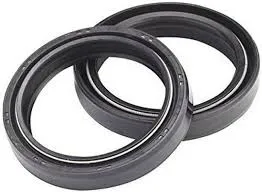THE 6 GUIDELINES ARE:
1 .Material: There are 7 types of material used for oil seals, they are.
- Leather Oil Seals – They are also known as Type L Oil Seals and are used most with parts that are subject to dirt and poor lubrication. They are pre-lubricated and can absorb fluids and can provide sealing properties in conditions that synthetic rubber is unable to.
- Synthetic Rubber Oil Seals – Known as SBR Oil Seals one of the most popular oil seals as the rubber has strong resistance to abrasions and lesions which makes them ideal for fast-moving machinery. Rubber can also withstand extreme temperatures which is why it is heavily used in outdoor components.
- Nitrile Oil Seals – Also known as Acrylonitrile-butadiene rubber seals, is a particularly good general-purpose option due to its flexibility of usage. They are the most often used oil seal due to its strong resistance against hot water, fats and animal oils, gasoline, mineral oils, and grease. They cannot however survive extreme temperatures.
- Viton Oil Seals – Viton is a form of synthetic rubber and fluoropolymer elastomer; these seals provide resistance in both high temperatures up to 250°C and low compression set components. They are also strong against abrasions and chemicals, so they can be used in machinery and elements that operate with solvents and petroleum.
- Polyacrylate Oil Seals – Are mostly used in automotive and transmission industries as they can withstand fuel, oil, ozone, sunlight, and weather when used. With cars being exposed these daily they are the perfect choice. They do however become increasingly less flexible the lower the temperature gets.
- Silicone Oil Seals – Are designed to specifically to absorb excess lubricants and less the friction and wear. They offer high thermal resistance and a large temperature range. However, they don’t handle abrasions and oxidized oils well.
-
Rotary Wheel Of Auto Parts

- PTFE Oil Seals – Are a relatively new oil seal, the use of polytetrafluoroethylene means they can withstand dry and unlubricated operations. They have a massive thermal range spanning from -130°C to more than 200°C and a strong resistance to chemicals, they are the future of rotary shaft seals.